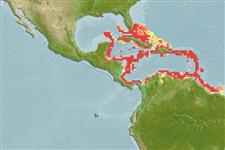>
Eupercaria/misc (Various families in series Eupercaria) >
Lutjanidae (Snappers) > Etelinae
Etymology: Pristipomoides: Greek, pristis = saw + Greek, poma, -atos = cover, operculum + Greek, oides = similar to (Ref. 45335).
More on authors: Müller & Troschel.
Environment: milieu / climate zone / depth range / distribution range
Écologie
marin benthopélagique; profondeur 110 - 550 m (Ref. 55). Deep-water; 27°N - 5°N, 89°W - 53°W (Ref. 55)
Western Central Atlantic: Straits of Florida, Bahamas, Greater Antilles and the Caribbean coast of Nicaragua and Panama.
Length at first maturity / Taille / Poids / Âge
Maturity: Lm 17.0, range 18 - ? cm
Max length : 50.0 cm TL mâle / non sexé; (Ref. 55); common length : 30.0 cm TL mâle / non sexé; (Ref. 55)
Épines dorsales (Total): 10; Rayons mous dorsaux (Total): 11; Épines anales 3; Rayons mous anaux: 8. Interorbital space flat. Eye large. Snout short and blunt. Pectoral fins long reaching level of anus. Scale rows on back parallel to lateral line. Back and upper sides pink with a silvery sheen, grading to silvery ventrally; the fins are translucent to pink.
Adults are most commonly found in deeper waters of the shelf near the edge of the continental slope. They feed on small fishes and larger planktonic animals. Marketed fresh.
Life cycle and mating behavior
Maturité | Reproduction | Frai | Œufs | Fécondité | Larves
Allen, G.R., 1985. FAO Species Catalogue. Vol. 6. Snappers of the world. An annotated and illustrated catalogue of lutjanid species known to date. FAO Fish. Synop. 125(6):208 p. Rome: FAO. (Ref. 55)
Statut dans la liste rouge de l'IUCN (Ref. 130435)
Menace pour l'homme
Harmless
Utilisations par l'homme
Pêcheries: intérêt commercial mineur
Plus d'informations
RéférencesAquacultureProfil d'aquacultureSouchesGénétiqueElectrophoresesHéritabilitéPathologiesTraitementNutrientsMass conversion
CollaborateursImagesStamps, Coins Misc.SonsCiguateraVitesseType de nageSurface branchialeOtolithesCerveauxVision
Outils
Articles particuliers
Télécharger en XML
Sources Internet
Estimates based on models
Preferred temperature (Ref.
123201): 13.6 - 22.3, mean 18.4 °C (based on 45 cells).
Phylogenetic diversity index (Ref.
82804): PD
50 = 0.5005 [Uniqueness, from 0.5 = low to 2.0 = high].
Bayesian length-weight: a=0.01660 (0.00874 - 0.03150), b=2.96 (2.80 - 3.12), in cm total length, based on LWR estimates for this species & Genus-body shape (Ref.
93245).
Niveau trophique (Ref.
69278): 3.9 ±0.56 se; based on food items.
Résilience (Ref.
120179): Milieu, temps minimum de doublement de population : 1,4 à 4,4 années (Preliminary K or Fecundity.).
Fishing Vulnerability (Ref.
59153): Moderate vulnerability (40 of 100).
Nutrients (Ref.
124155): Calcium = 17.4 [7.5, 44.1] mg/100g; Iron = 0.372 [0.162, 0.791] mg/100g; Protein = 17.1 [15.2, 18.9] %; Omega3 = 0.388 [0.170, 0.771] g/100g; Selenium = 18.4 [7.9, 40.4] μg/100g; VitaminA = 24.3 [5.3, 120.4] μg/100g; Zinc = 0.373 [0.242, 0.577] mg/100g (wet weight);
